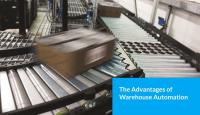 Add My Company
Add My Company
Sign In
The Advantages of Warehouse Automation
25-02-2019

Your warehouse is throttling your business and limiting your ability to grow, but what is the answer? Employing more people whilst increasing your operational costs; moving to a purpose-built site on that shiny new development around the corner or investment in automation? If your goal is boosting operational efficiency increasing headcount or relocation may offer short term benefit, but your issues or new ones will likely present themselves at some point. So, is the answer automation?
What is Warehouse Automation
But when we say Automation what do we actually mean, beyond the use of technology to control specific, repetitive tasks and perhaps more importantly how do you identify the most appropriate type of automation to invest in?? What follows is an overview of the key types of warehouse automation which may help clarify your thinking. Automating the physical – the transportation and movement of goods, where technologies such as Conveyors, AGV’s, Robotic Arms and Sortation machines speed up the process of moving goods from A to B as well reducing the potential for errors and improving safety within the warehouse.
Meanwhile, a warehouse management system or WMS will automatically collect, store and generate data about the two most important assets in your warehouse – your inventory and your personnel. Switching to a WMS gives you real-time information about your warehouse improving traceability, accountability and boosting efficiency.
These two ‘technologies’ can be deployed in isolation, but it gets really clever when they are used in combination. The ability for mechanical and software automation to be used in tandem creates the ultimate automated warehouse environment.
Below, we explain the full range of advantages of warehouse automation and provide some examples of the types of automation technologies available to invest in.
Faster warehouse operations
A primary advantage of warehouse automation is that it will speed up warehouse processes and improve turnaround time.
Equipment like automated conveyors and sortation systems can reduce the number of manual movements and touch points across a warehouse. Instead of workers physically moving single products, boxes or pallets from goods-in to storage, storage to dispatch or even to replenish the pick-face, this type technology has the potential to transport, route and sort hundreds of products per minute.
Industry reports suggest up to 50% of a pickers time is spent walking, whilst just a measly 15% is actually spent picking orders. A Warehouse Management System has the capability to dramatically reduce picking time in a warehouse. By simply calculating the fastest, most efficient walk routes and reducing travel time picking becomes a more efficient and more cost-effective process.
Better inventory management
It is easy to associate warehouse automation with the physical movement of goods through a warehouse, but some of the most important benefits can be realised through the automation of inventory information.
Warehouse management systems that automatically record information using tracking technology give warehouse managers greater visibility over their inventory – where it is, how many there are in stock for example. Users can receive items into the WMS at goods-in and the system will make decisions what happens next based on your business needs and then track goods in real-time from put-away to despatch.
This enhanced transparency of stock items across the warehouse allows you to make better informed decisions. For example, stock replenishment can be automated, re-ordering alerts can be programmed, and stock takes will be much faster if required at all. Warehouse management systems can also be used to create a just-in-time inventory system, meaning warehouses can hold onto less stock.
Lower warehouse staff costs
Warehouses that rely heavily on manual labour to function will need more staff to keep things running smoothly as the business grows. But what if growth did not mean spiralling wage costs?
Conveyor systems that reduce the need for manual movements and efficiency-generating warehouse management systems can both reduce the number of people required to work each shift and of course your wage bill.
As well as reducing wage costs, which can make up a significant proportion of any business’s operating costs, automation can also help tackle costs and headaches associated with short-term staff recruitment, staff retention and workplace accidents.
Fewer errors
Correcting errors costs time and money, whilst we humans are adaptable and dynamic in a way sometimes difficult to recreate using automation, we are also by way of contrast susceptible to the odd error in a way automation is not. As well as creating near hidden costs, errors can also damage a company’s reputation and alienate customers.
Whilst warehouse automation won’t eliminate all operational errors it will reduce their potential and is more likely to identify when, where and how they happened by adding in continuous checks and balances throughout every process. For example, a WMS system can improve the accuracy of the pick operation by not only routing the picker to the correct location but confirming with a scanner the right item and quantity has been picked and then packed into the right outer.
Maximising working capacity
A further advantage of warehouse automation is the ability to make the most of a warehouse with limited floor space by allowing you to expand up if you cannot expand out.
Automated logistics solutions, such as incline and decline conveyors, elevators and spiral conveyors all make it possible to take advantage of previously unused space and introduce mezzanine flooring to warehouses to increase storage and working space whilst still being able to move goods around efficiently.
Using a good warehouse management system will optimise storage space by utilising functionality such as Dynamic locations – rather than relying on pre-set rules where to store products the system will make decisions based on location availability, size and proximity. It will also direct you to put your faster moving items in easy access locations, or prioritising your pick based on a batch number or sell by date. As you are expected to hold increasing amounts of stock to facilitate your customers delivery expectations a WMS becomes an increasingly valuable ally.
Automation, in the form of a WMS or conveyor system or a combination of both, offers a wealth of advantages for any warehouse looking to improve efficiency, reduce errors, maximise throughput or increase operational transparency, Automation will make even the slowest and most laborious processes, well just happen, it also creates the opportunity to deploy the most dynamic and valuable asset within your warehouse – your team, more effectively, fully realising their unique strengths and capabilities. The right solution will also provide the time, space and capacity to fuel business growth.
If you’re considering automating your warehouse, make sure you work with a business that will take time to understand your process, your challenges and overall objectives, and suggest an automation strategy that will deliver the outcomes you need.
For more information on The Advantages of Warehouse Automation talk to Keymas Ltd
Enquire Now
List your company on FindTheNeedle.

